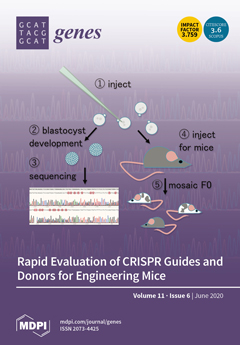Congenital hearing impairment is a sensory disorder that is genetically highly heterogeneous. By performing exome sequencing in two families with congenital nonsyndromic profound sensorineural hearing loss (SNHL), we identified autosomal dominantly inherited missense variants [p.(Asn283Ser); p.(Thr116Ile)] in
GREB1L, a neural crest regulatory
[...] Read more.
Congenital hearing impairment is a sensory disorder that is genetically highly heterogeneous. By performing exome sequencing in two families with congenital nonsyndromic profound sensorineural hearing loss (SNHL), we identified autosomal dominantly inherited missense variants [p.(Asn283Ser); p.(Thr116Ile)] in
GREB1L, a neural crest regulatory molecule. The p.(Thr116Ile) variant was also associated with bilateral cochlear aplasia and cochlear nerve aplasia upon temporal bone imaging, an ultra-rare phenotype previously seen in patients with de novo
GREB1L variants. An important role of GREB1L in normal ear development has also been demonstrated by
greb1l−/− zebrafish, which show an abnormal sensory epithelia innervation. Last, we performed a review of all disease-associated variation described in
GREB1L, as it has also been implicated in renal, bladder and genital malformations. We show that the spectrum of features associated with
GREB1L is broad, variable and with a high level of reduced penetrance, which is typically characteristic of neurocristopathies. So far, seven
GREB1L variants (14%) have been associated with ear-related abnormalities. In conclusion, these results show that autosomal dominantly inherited variants in
GREB1L cause profound SNHL. Furthermore, we provide an overview of the phenotypic spectrum associated with
GREB1L variants and strengthen the evidence of the involvement of
GREB1L in human hearing.
Full article






